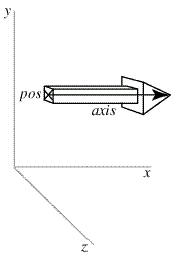If you're new to Python
and VPython see more
Help at glowscript.org
Pictures of 3D objects
arrow |
 |
 The arrow object has a straight box-shaped shaft with an arrowhead at one end. The following statement will display an arrow pointing parallel to the x axis:
The arrow object has a straight box-shaped shaft with an arrowhead at one end. The following statement will display an arrow pointing parallel to the x axis:
pointer = arrow(pos=vector(0,2,1), axis=vector(5,0,0), shaftwidth=1)
The arrow object has the following attributes and default values, like those for cylinders: pos (0,0,0), axis (1,0,0), length (1), color (1,1,1) which is color.white, red (1), green (1), blue (1), opacity (1), shininess (0.6), emissive (False), texture, and up (0,1,0). As with box, the up attribute is significant for arrow because the shaft and head have square cross sections, and setting the up attribute rotates the arrow about its axis. Additional arrow attributes:
shaftwidth By default, shaftwidth = 0.1*(length of arrow)
headwidth By default, headwidth = 2*shaftwidth
headlength By default, headlength = 3*shaftwidth
Assigning shaftwidth = 0 makes it be the default (0.1 times the length of the arrow). If you don't explicitly set headwidth or headlength, its length is based as shown above on shaftwidth (either the default or whatever value you specify for shaftwidth). If headlength becomes larger than half the length of the arrow, or the shaft becomes thinner than 1/50 the length, the entire arrow is scaled accordingly.
This default behavior makes the widths of very short arrows shrink, and the widths of very long arrows grow (while displaying the correct total length). If you prefer that shaftwidth and headwidth not change as the arrow gets very short or very long, specify the desired shaftwidth. In this case the only adjustment that is made is that headlength is adjusted so that it never gets longer than half the total length, so that the total length of the arrow is correct. This means that very short, thick arrows look similar to a thumbtack, with a nearly flat head.
Note that the pos attribute for cylinder, arrow, cone, and pyramid corresponds to one end of the object, whereas for a box, sphere, or ring it corresponds to the center of the object.
If you include make_trail=True when you create the object, a trail will be left behind the object as you move it. For related options, see Leaving a Trail.
See Rotating an Object for an easy way to change the orientation of an object.
See description of Additional Attributes available for all 3D display objects.